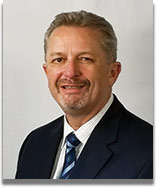
Malcolm Aitken, VP of Sales, ID Label
A manufacturer of high-quality labeling solutions engineered for specific environments and applications, ID Label provides custom labels, signs, installation and floor striping for today’s smart warehouses and distribution centers (DCs). Malcolm Aitken, the company’s VP of sales, explains how a large, national carrier is using the company’s products to save time, improve accuracy and save money.
Q: What challenge was your customer facing?
Aitken: The national transportation carrier has about 34 cross-dock style locations across the US. It was implementing a new warehouse management system (WMS) in each of those facilities, which meant each site would require new barcode labeling and signage. The new labeling system had to be consistent across all locations so the company could track products everywhere in their system.
For example, a warehouse manager in Milwaukee needed visibility into what was happening in Salt Lake City—including what truck a product was on, or where it was in transit to. All of the company’s locations were “live” and very busy, so getting the solution in place—as each facility was coming online with the new WMS—required detailed planning and some evening and overnight installation work in some locations.
Q: How did the customer discover ID Label and its solutions?
Aitken: The company found us online and made an inquiry through our website. We were chosen based on our flexibility to be able to work with the customer in different locations, depending on the specific challenges associated with each location. We stepped up to the plate and agreed to a tight 18-month installation timeframe that started with their Milwaukee location, which is fortunately very close to our headquarters.
Q: What were the next steps in the process?
Aitken: We went on site, completed a full evaluation, provided our ideas and developed a solution. That solution had to work across the company’s locations and despite the different challenges that each of those facilities was facing. As with most warehousing transport companies, no single location is the same as the next from the configuration standpoint. Some are square, some are rectangular and others are L-shaped.
Our engineers came up with a durable design and our materials team developed a solution that would work across all of the company’s facilities, regardless of their configuration (e.g., higher ceilings, longer-distance scanning, etc.). With the barcode scanning, for example, we factored in the maximum distance that users would be scanning from, which is 35 feet.
Q: Did you incorporate any other unique engineering or design elements?
Aitken: Yes, we customized some of the barcoding sizes for the customer and made retroreflective signs that hang on cables above pallet and bulk locations. The long-range scanning allowed the customer to put onboard scanning equipment onto every one of its lift trucks. That way, the driver can sit and simply shoot to scan above the pallets.
We also incorporated our BullsEye totems, which include all of the barcodes for the different levels of stacked pallets on a single label. The totems are made with a very thick laminate to protect them from vehicle strikes and ensure durability. Drivers can scan the barcodes while seated on the lift truck, which helps save time, reduce strain and improve safety.
From a production standpoint, everything was manufactured here in our Lake Villa, Ill., factory. We encouraged the customer to give us multiple data files for the next three or four locations so we could batch them together and run more labels at once. This created production efficiencies and also saved money for the customer. That was a win-win for everyone.
We also installed all of the labels and signs across their facilities. A lot of this was done during the height of the COVID-19 pandemic, so we had to manage where the hotspots were and safely work to avoid them. Despite the challenges, we delivered and installed our turnkey solution within the 18-month timeframe.
Q: What overall benefits did the customer get?
Aitken: Our customer really wanted to have visibility into where everything was at any given point across all of its locations, and we helped them achieve that. They wanted freight managers with mobile apps and tablets to be able to get into their WMS and say, “Oh yes, that order is on the truck between Pittsburgh and Philadelphia right now.”
That’s how granular they wanted to get, and we helped them achieve that goal by providing the link between the WMS and the facilities themselves. The bottom line is that WMS doesn’t work without the right barcode solution in place. Companies buy millions of dollars worth of systems, racking, software and equipment, but don’t always understand the importance of the label itself to making everything work.
Article topics










